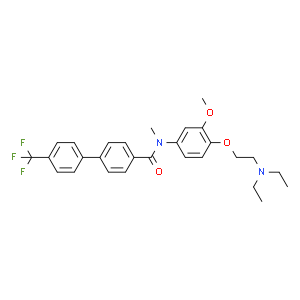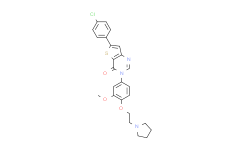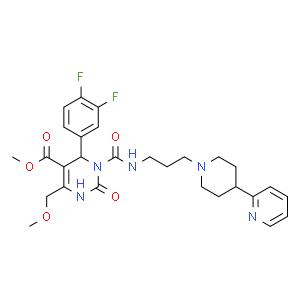| 中文名称: | SB-568849 | ||||
|---|---|---|---|---|---|
| 英文名称: | SB-568849 | ||||
| 别名: | N-(4-(2-(Diethylamino)ethoxy)-3-methoxyphenyl)-N-methyl-4'-(trifluoromethyl)-[1,1'-biphenyl]-4-carboxamide | ||||
| CAS No: | 395679-53-5 | 分子式: | C28H31F3N2O3 | 分子量: | 500.55 |
| CAS No: | 395679-53-5 | ||||
| 分子式: | C28H31F3N2O3 | ||||
| 分子量: | 500.55 | ||||
基本信息
|
产品编号: |
S11180 |
||||
|
产品名称: |
SB-568849 |
||||
|
CAS: |
395679-53-5 |
储存条件 |
粉末 |
-20℃ |
四年 |
|
分子式: |
溶于液体 |
-80℃ |
二年 |
||
|
分子量: |
500.55 |
|
|
||
|
化学名: |
N-(4-(2-(Diethylamino)ethoxy)-3-methoxyphenyl)-N-methyl-4'-(trifluoromethyl)-[1,1'-biphenyl]-4-carboxamide |
||||
|
Solubility (25°C): |
|||||
|
体外:
|
DMSO |
|
|||
|
Ethanol |
|
||||
|
Water |
|
||||
|
体内(现配现用): |
|
||||
|
<1mg/ml表示微溶或不溶。 |
|||||
|
普西唐提供的所有化合物浓度为内部测试所得,实际溶液度可能与公布值有所偏差,属于正常的批间细微差异现象。 |
|||||
|
请根据产品在不同溶剂中的溶解度选择合适的溶剂配制储备液;⼀旦配成溶液,请分装保存,避免反复冻融造成的产品失效。 |
|||||
生物活性
|
产品描述 |
一种黑色素浓缩激素受体 1 (MCH R1) 拮抗剂,pKi 值为 7.7。 |
|
靶点 |
MCH R1 receptor |
|
体外研究 |
SB-568849 is a selective SLC-1 antagonist with a pKi of 7.7 as determined in radioligand binding displacement assays;coincubation of tissue with 1μM SB-568849 for 45 min completely inhibits the MCH induced increase in corticotropinreleasing factor (CRF) release to basal levels without causing any effect on its own. The only reported MCH receptor in the rat is SLC-1,a G protein coupled receptor found throughout the brain and periphery. |
|
体内研究 |
SB-568849 (Compound 15h) possesses good receptor affinity and selectivity.SB-568849 proves to be an antagonist with stability in vivo,an acceptable brain–blood ratio and oral bioavailability.SB 568849 retains affinity,demonstrates greater in vivo stability (CLb=16mL/min/kg) and shows an acceptable brain-blood ratio of 1. SB-568849 also shows >30-fold selectivity over a wide range of monoamine receptors and is an antagonist in the FLIPR assay with a pKb of 7.7. |
本计算器可帮助您计算出特定溶液中溶质的质量、溶液浓度和体积之间的关系,公式为:
质量 (g) = 浓度 (mol/L) x 体积 (L) x 分子量 (g/mol)
摩尔浓度计算公式
用本工具协助配置特定浓度的溶液,使用的计算公式为:
开始浓度 x 开始体积 = 最终浓度 x 最终体积
稀释公式
稀释公式一般简略地表示为:C1V1 = C2V2 ( 输入 输出 )










